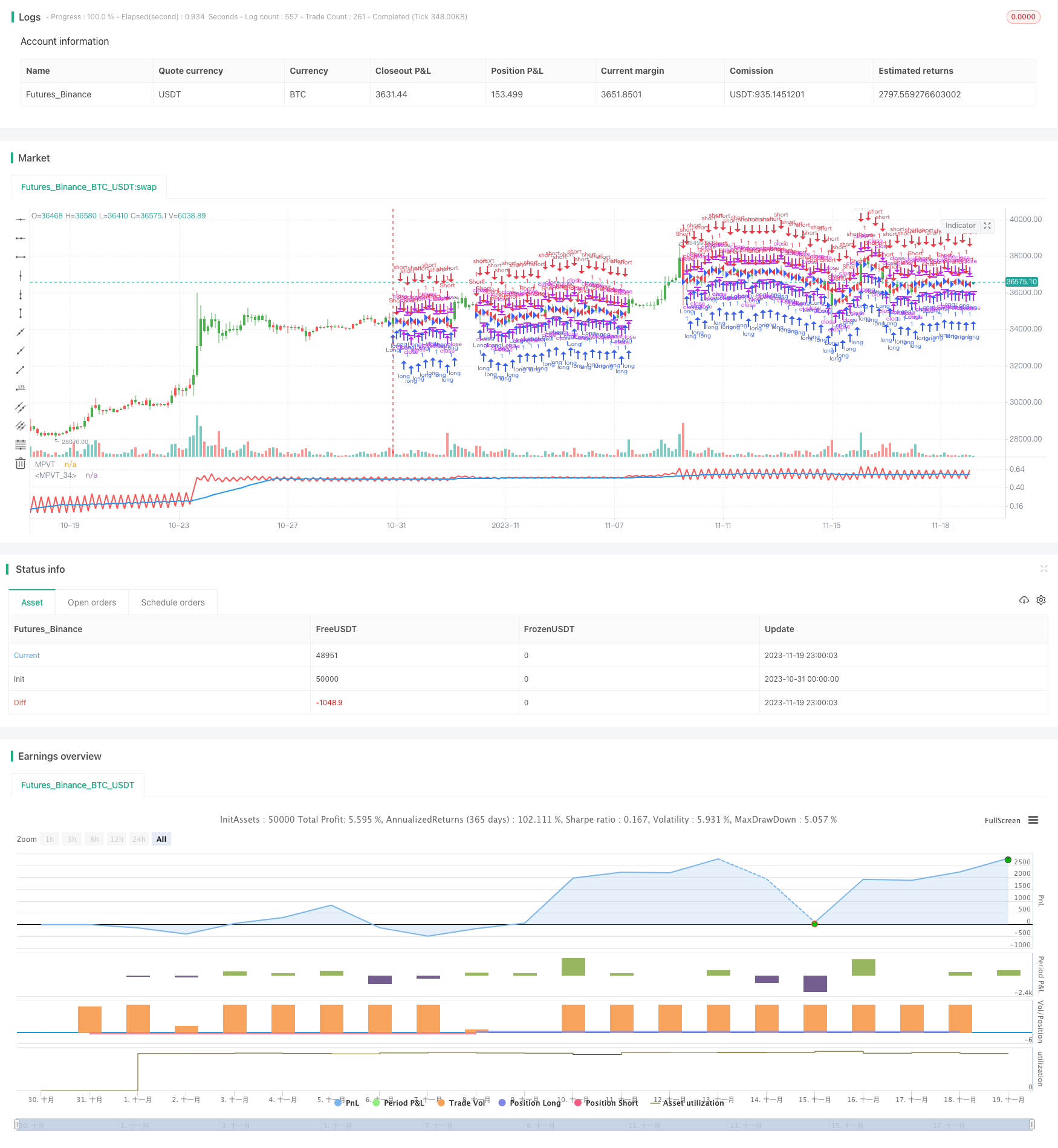
概述
本策略名称为“基于价格量变动的趋势策略”。该策略通过计算价格和交易量的累计变动情况,结合移动平均线构建长短仓单,实现追踪趋势的目的。
策略原理
该策略的核心指标是价量累计变动指标(MPVT)。该指标通过价格和交易量的变化情况,反映市场人气和资金流入流出的情况。具体计算公式如下:
rV = 交易量 / 50000
xCumPVT = 昨日xCumPVT + (rV * (最新收盘价 - 昨日收盘价) / 昨日收盘价)
然后结合参数Level和Scale,构建价量变动Residence指标:
nRes = Level + Scale * xCumPVT
Residence指标反映了价格和交易量的综合变化。当其上穿其N日简单移动平均线时,做多;当其下穿其N日简单移动平均线时,做空。
优势分析
该策略主要具有以下优势:
- 通过价量指标判断市场人气和资金流向,可以及时捕捉到趋势的转折点。
- 结合参数优化,可以灵活调整策略的参数,适应不同市场环境。
- 可以通过反向输入参数,实现做空策略,扩大策略运用场景。
风险分析
该策略也存在一些风险:
- 价量指标容易产生错误信号,可能出现突破不成立的情况。可以适当调整参数或结合其他指标进行过滤。
- 趋势行情适用性更好,盘整行情容易产生错误信号。可以考虑与趋势和波动率指标进行组合。
- 参数优化效果取决于历史周期,可能产生过拟合风险。应适当调整参数或采用步进优化方法。
优化方向
该策略可以考虑从以下几个方面进行优化:
可以测试不同的移动平均线,如加权移动平均线、EMA等进行组合,看哪种效果更好。
可以结合其他指标,如RSI、KD等进行过滤信号,减少错误信号发生概率。
可以测试不同的参数组合,寻找最佳参数对。也可以采用步进优化方法,让参数实时更新。
可以通过和趋势以下指标,如布林带进行组合,提高策略的稳定性。
总结
本策略通过计算价格和交易量变化累计值,设计出价量变动Residence指标,能够有效反映市场资金流入流出情况,是一种典型的价量COMBO策略。该策略简单实用,适用于趋势行情,通过参数优化和指标组合优化空间大,是非常值得推荐的趋势策略。
策略源码
/*backtest
start: 2023-10-31 00:00:00
end: 2023-11-20 00:00:00
period: 3h
basePeriod: 15m
exchanges: [{"eid":"Futures_Binance","currency":"BTC_USDT"}]
*/
//@version=2
////////////////////////////////////////////////////////////
// Copyright by HPotter v1.0 20/07/2018
// The related article is copyrighted material from
// Stocks & Commodities.
// Strategy by HPotter.
//
// You can change long to short in the Input Settings
// WARNING:
// - For purpose educate only
// - This script to change bars colors.
////////////////////////////////////////////////////////////
strategy(title="Modified Price-Volume Trend Backtest", shorttitle="MPVT")
Level = input(0)
Scale = input(1)
Length = input(23)
reverse = input(false, title="Trade reverse")
xOHLC4 = ohlc4
xV = volume
rV = xV / 50000
xCumPVT = nz(xCumPVT[1]) + (rV * (xOHLC4 - xOHLC4[1]) / xOHLC4[1])
nRes = Level + Scale * xCumPVT
xMARes = sma(nRes, Length)
pos = iff(nRes > xMARes, 1,
iff(nRes < xMARes, -1, nz(pos[1], 0)))
possig = iff(reverse and pos == 1, -1,
iff(reverse and pos == -1, 1, pos))
if (possig == 1)
strategy.entry("Long", strategy.long)
if (possig == -1)
strategy.entry("Short", strategy.short)
barcolor(possig == -1 ? red: possig == 1 ? green : blue )
plot(nRes, color=red, title="MPVT", linewidth = 2)
plot(xMARes, color=blue, title="MPVT", linewidth = 2)